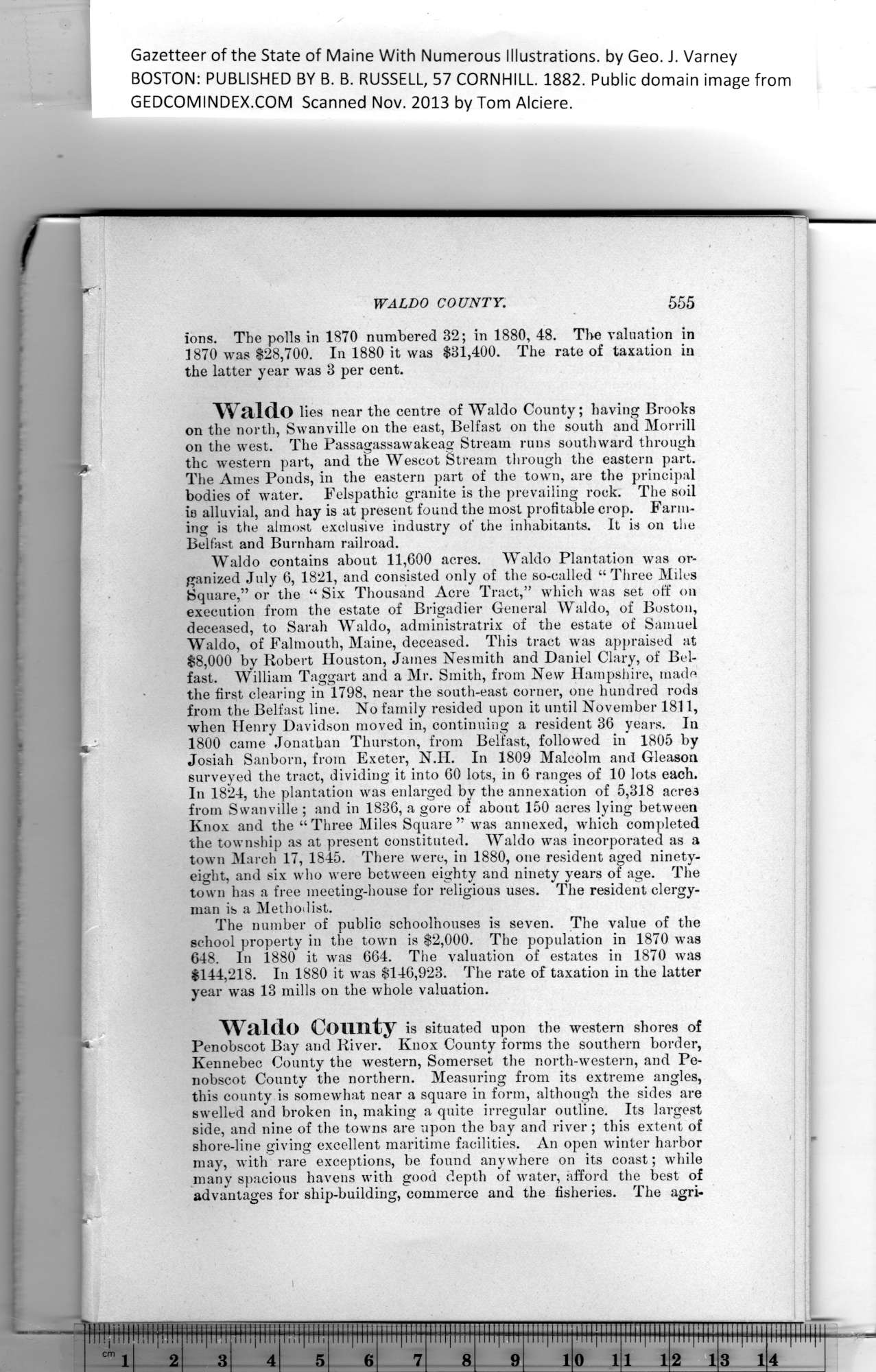|
Gazetteer of the State of Maine With Numerous Illustrations, by Geo. J. Varney
BOSTON: PUBLISHED BY B. B. RUSSELL, 57 CORNHILL. 1882. Public domain image from
WALDO COUNTY.
ions. The polls in 1870 numbered 32; in 1880, 48. The valuation in
1870 was $28,700. In 1880 it was $31,400. The rate of taxation in
the latter year was 3 per cent.
Waldo lies near the centre of Waldo County; having Brooks
on the north, Swanville on the east, Belfast on the south and Morrill
on the west. The Passagassawakeag Stream runs southward through
the western part, and the Wescot Stream through the eastern part.
The Ames Ponds, in the eastern part of the town, are the principal
bodies of water. Felspathic granite is the prevailing rock. The soil
is alluvial, and hay is at present found the most profitable crop. Farm-
ing is the almost exclusive industry of the inhabitants. It is on the
Belfast and Burnham railroad.
Waldo contains about 11,600 acres. Waldo Plantation was or-
ganized July 6, 1821, and consisted only of the so-called “ Three Miles
Square,” or the “ Six Thousand Acre Tract,” which was set off on
execution from the estate of Brigadier General Waldo, of Boston,
deceased, to Sarah Waldo, administratrix of the estate of Samuel
Waldo, of Falmouth, Maine, deceased. This tract was appraised at
$8,000 by Robert Houston, James Nesmith and Daniel Clary, of Bel-
fast. William Taggart and a Mr. Smith, from New Hampshire, made
the first clearing in 1798, near the south-east corner, one hundred rods
from the Belfast line. No family resided upon it until November 1811,
when Henry Davidson moved in, continuing a resident 36 years. In
1800 came Jonathan Thurston, from Belfast, followed in 1805 by
Josiah Sanborn, from Exeter, N.H. In 1809 Malcolm and Gleason
surveyed the tract, dividing it into 60 lots, in 6 ranges of 10 lots each.
In 1824, the plantation was enlarged by the annexation of 5,318 acres
from Swanville ; and in 1836, a gore of about 150 acres lying between
Knox and the “ Three Miles Square ” was annexed, which completed
the township as at present constituted. Waldo was incorporated as a
town March 17, 1845. There were, in 1880, one resident aged ninety-
eight, and six who were between eighty and ninety years of age. The
town has a free meeting-house for religious uses. The resident clergy-
man is a Methodist.
The number of public schoolhouses is seven. The value of the
school property in the town is $2,000. The population in 1870 was
648. In 1880 it was 664. The valuation of estates in 1870 was
$144,218. In 1880 it was $146,923. The rate of taxation in the latter
year was 13 mills on the whole valuation.
Waldo County is situated upon the western shores of
Penobscot Bay and River. Knox County forms the southern border,
Kennebec County the western, Somerset the north-western, and Pe-
nobscot County the northern. Measuring from its extreme angles,
this county is somewhat near a square in form, although the sides are
swelled and broken in, making a quite irregular outline. Its largest
side, and nine of the towns are upon the bay and river; this extent of
shore-line giving excellent maritime facilities. An open winter harbor
may, with rare exceptions, be found anywhere on its coast; while
many spacious havens with good depth of water, afford the best of
advantages for ship-building, commerce and the fisheries. The agri-
UMfniMMiiiiiiiiiiiMfiiiiuiifniiiiiimiiuiiiiiiiiiiiiiMdiiMtiiiiliiniTlMIIIII
0 1
PREVIOUS PAGE ... NEXT PAGE
This page was written in HTML using a program written in Python 3.2
|
